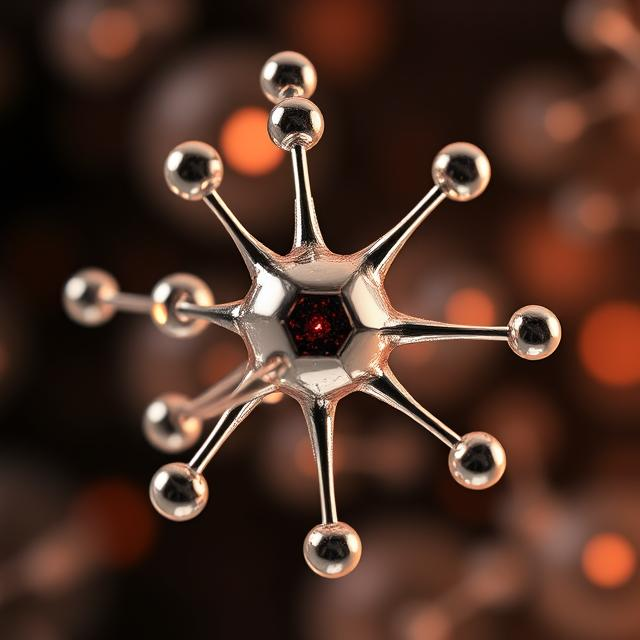Glucose oxidase (GOx) has emerged as a keystone enzyme in the modern biosensor landscape, particularly within the field of glucose monitoring technologies. Its primary biochemical role involves the oxidation of β-D-glucose to D-glucono-δ-lactone, generating hydrogen peroxide as a by-product. This reaction is not only precise but highly predictable, making GOx one of the most widely used enzymes in diagnostic applications. With the global rise in diabetes and the subsequent demand for continuous glucose monitoring (CGM), the relevance of GOx fermentation and its integration into biosensor platforms has never been more significant.
Understanding Glucose Oxidase and Its Mechanism Glucose oxidase belongs to the oxidoreductase enzyme class, and it specifically targets β-D-glucose. It uses molecular oxygen as an electron acceptor, leading to the production of hydrogen peroxide (H2O2) and gluconic acid. The generated H2O2 can then be detected electrochemically, allowing for quantifiable glucose concentration readings. The reaction is as follows:

β-D-glucose + O2 → D-glucono-δ-lactone + H2O2
The ability to measure glucose concentration by monitoring H2O2 production is central to many biosensor designs, particularly in diabetic monitoring systems. GOx is highly specific, has a strong catalytic efficiency, and functions under mild conditions, all of which are critical for sensitive and selective biosensor performance.
The Microbial Source: Fermenting GOx The primary industrial sources of glucose oxidase are fungi, particularly Aspergillus niger and Penicillium amagasakiense. These organisms are capable of secreting GOx extracellularly, simplifying the downstream extraction and purification processes.
More recently, advances in recombinant DNA technology have facilitated the expression of GOx in heterologous systems like Saccharomyces cerevisiae. Recombinant expression offers multiple advantages:
- Higher Yields: Recombinant yeast strains can produce up to 3 grams of purified enzyme per liter of culture.
- Controlled Conditions: Genetic modifications allow for better regulation of GOx expression and activity.
- Purity: Fermentation coupled with affinity chromatography or ultrafiltration can yield >95% purity.
Fermentation Techniques and Optimization GOx fermentation involves aerobic cultivation in bioreactors, where pH, temperature, dissolved oxygen, and nutrient levels are carefully controlled. The process typically follows these stages:
- Inoculum Preparation: Starter cultures are grown in seed tanks before transferring to production fermenters.
- Growth Phase: The biomass increases rapidly under optimal growth conditions.
- Induction/Production Phase: Enzyme production begins, often in response to limited glucose availability or the addition of specific inducers.
- Harvesting and Purification: The culture broth is filtered, and GOx is purified via ultrafiltration, ion exchange chromatography, or affinity tags.
Key optimization parameters include:
- Carbon Source: Glucose or sucrose supports initial growth; however, GOx production often increases under carbon-limited conditions.
- Aeration and Agitation: Ensures sufficient oxygen supply and homogeneity.
- pH and Temperature: Typically maintained around 5.5 and 30°C for A. niger.
Challenges in GOx Fermentation Despite its widespread use, GOx production is not without challenges:
- Yield Variability: Natural isolates can have unpredictable productivity.
- Stability: GOx is sensitive to heat and proteolysis.
- Cost: Although microbial fermentation reduces costs, downstream processing remains expensive.
Biotechnologists are currently exploring CRISPR-Cas9-based genome editing to improve GOx expression and thermostability. Synthetic biology approaches are also being investigated to design microbial strains with enhanced secretion capabilities.
The Chemistry of Detection Once GOx catalyzes the oxidation of glucose, the resultant hydrogen peroxide can be detected using various methods:
- Electrochemical Detection: Common in biosensors. Involves a platinum or carbon electrode detecting the oxidation of H2O2.
- Colorimetric Detection: Uses peroxidase enzymes to generate a color change.
- Fluorescent Probes: Offer high sensitivity and are used in laboratory applications.
These detection methods form the basis of both commercial and DIY biosensor platforms.
Open-Source Biosensing: Democratizing Glucose Testing In an era where healthcare costs are rising, open-source projects like the Arduino Glucometer aim to make glucose monitoring more accessible. Pioneered by individuals like Markus Bindhammer, these initiatives are built on the simplicity and reliability of GOx chemistry.
Bindhammer’s system leverages GOx immobilized on test strips and a custom reader to measure the resultant H2O2 electrochemically. Though supply chain challenges, especially in sourcing high-purity GOx, have delayed widespread adoption, the potential remains immense.
Conclusion of Part I The biochemical elegance of glucose oxidase, coupled with robust fermentation strategies, has made it a linchpin of modern biosensing. As we transition into continuous glucose monitoring and wearable biosensors, understanding and optimizing GOx production is more important than ever.
In Part II, we will explore how glucose oxidase is integrated into continuous glucose monitoring systems (CGMs), the rise of implantable sensors, and how this enzyme continues to shape the future of personalized healthcare.
Glucose Oxidase Fermentation & Continuous Glucose Monitoring – The Frontier of Bioelectronic Sensing
In Part I, we explored the fundamentals of glucose oxidase (GOx), its enzymatic mechanism, and the historical backdrop that paved the way for biosensors and glucose monitoring. Now, in Part II, we take a deeper dive into the rapidly evolving world of continuous glucose monitoring (CGM), the challenges in enzyme sourcing, and the role of fermentation biotechnology in scaling production. With the convergence of miniaturized electronics, wearable technology, and biomanufacturing, glucose oxidase fermentation is at the heart of a biosensor revolution.
Continuous Glucose Monitoring: A Shift from Episodic to Real-Time Insight
Traditional blood glucose monitoring required finger-pricks and reactive measurement. CGM devices, however, provide real-time, dynamic insights by detecting interstitial glucose levels every few minutes. At the center of this innovation is glucose oxidase, which catalyzes the conversion of glucose to gluconolactone, generating hydrogen peroxide as a byproduct. The presence of H2O2 is electrochemically detectable and directly proportional to glucose concentration.
Advantages of CGM systems powered by GOx biosensors:
- Continuous Insight: Unlike static glucose readings, CGM gives a detailed glycemic profile, including nocturnal trends and postprandial spikes.
- Predictive Data: Devices can now trigger alarms or send notifications for hypo/hyperglycemic events.
- Therapeutic Feedback: Allows for real-time data correlation with food intake, insulin doses, or exercise.
Notable CGM Technologies:
- Dexcom G7: Utilizes GOx-based electrochemical detection in a compact wearable patch.
- Glucotrack (Nasdaq): Recently completed human trials for an implantable CGM device lasting three years with no external on-body component.
As Dr. David Klonoff of UCSF explains, glucose elevations post-meal are often more predictive of prediabetes than even HbA1c. CGMs now play a vital role not only for insulin-dependent diabetics but also for early detection and prevention in non-diabetic users.
Enzyme Supply Chain: The Glucose Oxidase Bottleneck
While CGM systems have become more refined, their biochemical core still relies on stable, high-purity glucose oxidase. Traditionally sourced from Aspergillus niger, GOx production is prone to supply chain limitations. These include:
- Fermentation inefficiency: Wild-type strains often yield low volumetric productivity.
- Batch variation: Differences in growth phase, pH, and oxygen availability alter enzyme kinetics.
- Downstream purification: High-purity GOx for biosensors requires expensive filtration and lyophilization.
These limitations underscore the need for optimized GOx fermentation platforms. Companies are engineering hyper-producing A. niger strains or using alternative fungal hosts like Penicillium and even recombinant yeast systems.
Modern bioprocess improvements include:
- Fed-batch fermentation with real-time glucose and DO monitoring
- CRISPR-based pathway knockouts to minimize protease expression
- Use of oxygen vectors and surfactants to enhance oxygen transfer in bioreactors
Fun fact: Markus Bindhammer, a DIY innovator featured on Hackaday, attempted to build an open-source glucometer but was hampered by the difficulty of sourcing GOx—showing that even hobbyists face the same bottleneck as major manufacturers.
From Fermenter to Sensor: The Manufacturing Workflow
Producing GOx for biosensors involves several critical steps beyond fermentation:
- Upstream Fermentation:
- Substrate: Typically glucose with yeast extract or ammonium salts
- Conditions: pH 5.5, 30°C, high aeration
- Duration: 5–7 days
- Cell Harvest & Lysis:
- Mechanical disruption or enzymatic lysis
- Centrifugation to separate cell debris
- Purification:
- Ultrafiltration for volume reduction
- Ion-exchange chromatography for charge-based purification
- Gel filtration or HPLC for polishing
- Formulation & Stabilization:
- Lyophilization with sugars or polymers for stabilization
- Encapsulation into membrane matrices or nanoparticles for biosensor use
The Biochemistry Behind GOx Stability
Glucose oxidase is a flavoprotein with FAD (flavin adenine dinucleotide) as a tightly bound cofactor. Its long-term function depends on maintaining tertiary structure and FAD-binding stability.
Key factors for biosensor-grade enzyme stability:
- Temperature: Enzyme half-life drastically decreases above 45°C
- pH range: Optimal activity at pH 5.5–6.5
- Metal ions: Cu2+ and Fe3+ can denature GOx
- Formulation: Use of PEG, trehalose, or BSA to prevent denaturation
Innovative sensor designs now employ nanozymes or synthetic GOx mimetics, but none match the natural enzyme’s specificity and kinetics.
Non-Invasive Monitoring: The Next Leap
The ultimate goal for glucose sensing is to eliminate the need for skin-piercing entirely. Non-invasive systems are in early development but face challenges in signal fidelity. The GOx-H2O2 mechanism currently remains too sensitive to interstitial placement or microneedle platforms.
Still, some promising routes include:
- Optical sensors using GOx to modulate fluorescence
- Implantable hydrogels with embedded enzymes and Bluetooth-enabled readers
- Salivary biosensors, where GOx interacts with trace glucose levels in oral fluid
Societal Impact & The Quantified Self Movement
GOx-powered CGMs have reshaped how diabetics and even health enthusiasts manage their daily routines. As noted in the Gonzaga Bulletin, people using CGMs experience a profound connection to their metabolic state. Visualizing real-time glucose fluctuations promotes behavioral change and dietary mindfulness.
This empowerment isn’t limited to diabetics:
- Fitness enthusiasts use CGMs to optimize carb timing and performance
- Biohackers correlate glucose with sleep, mood, and cognition
- Preventive care practitioners recommend CGMs for high-risk patients
As continuous monitoring becomes normalized, GOx-based biosensors may evolve from medical necessity into everyday health accessories—comparable to smartwatches.
Looking Forward
Glucose oxidase fermentation is no longer a niche biotech process—it’s the lynchpin in a $15B+ global biosensor market. As innovation continues:
- Synthetic biology may yield GOx variants with improved thermal stability and oxygen independence
- Microbial consortia or cell-free systems could further accelerate production
- Integration with AI-driven wearables may close the loop between measurement and real-time insulin delivery
The simplicity of the glucose oxidase reaction belies its powerful applications. From fermenters to fingertips, this enzyme is more than a molecule—it’s a bridge between the body and the digital world.
In future parts, we’ll dive into GOx engineering strategies, synthetic mimetics, and the rise of wearable biosensor ecosystems. For now, it’s clear: the next generation of personal health will be measured in micromoles, built on enzymes, and powered by fermentation.
